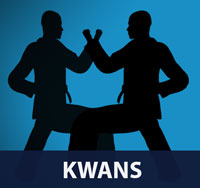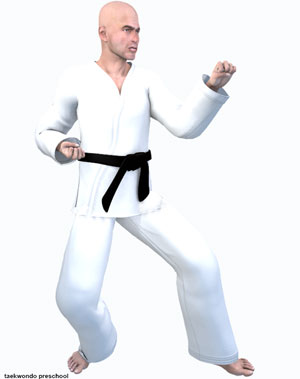Taekwondo 태권도Taekwondo Preschool
Promotion from one geup to the next can proceed rapidly in some schools, since schools often allow geup promotions every two, three, or four months. Students of geup rank learn the most basic techniques first, and then move on to more advanced techniques as they approach first dan. Many of the older and more traditional schools often take longer to allow students to test for higher ranks than newer, more contemporary schools, as they may not have the required testing intervals. View Taekwondo belt levels »

Song Moo Kwan 송무관
The original Taekwondo Kwans. In Korean literally means building or hall, but when used in martial arts it can also refer to a school or clan of martial artists who follow the same style and/or leader.
Song Moo Kwan 송무관, originally named Song Do Kwan, is one of the nine original kwans (martial art schools) of taekwondo in Korea. Its founder, from 1944, Byung Jick Roh, is one of the highest ranking taekwondo practitioners in the world.
History
Byung Jick Roh was born July 3, 1919, in Kaesung City, Korea. Frail health forced him to enter school a year later than normal. At the age of 12, his interest in the martial arts intensified as he watched the techniques practised in local temples. He was inspired to train with intense dedication, which subsequently strengthened him and improved his health.
As a young man, Ro traveled to Japan to attend Chuo University. He sought out Shotokan founder, Gichin Funakoshi. Beginning in 1936, Ro studied Shotokan under Funakoshi, along with Chung Do Kwan founder, Won Kuk Lee. Ro subsequently earned his black belt. During college vacations, he returned home and taught friends and neighbors the techniques he had learned. In February 1944, he returned to Korea, where he continued to create additional hand and foot techniques of his own.
Honoring numerous training requests, he opened the Kaesung dojang on March 11, 1944 in the Kwan Duck Jung archery school, establishing the first of the "original founding kwans". Unfortunately, due to the situation in Korea during this time, the dojang was forced to close within three to four months after opening. It was the end of World War II, and Korea was under Japanese occupation. Survival was the first priority for the people of Korea, and training in the martial arts was far from their minds. On May 2, 1946, Ro re-established his art at Dong Hung Dong. For the next few years, martial arts swept through the Korean general population and began to thrive as additional Kwans sprang up. However, war would again cause Ro and the rest of the founders to abandon their dreams, as the Korean War forced them to close their doors.
Early Song Moo Kwan practice sessions started with an hour of warm-up exercises consisting of lifting weights and then practicing on the Kwon Go (makiwara). Byung Jick Roh was known as a powerful puncher and kicker from his students. He always let his students punch the Kwon Go at least 100 times and then started the real practice. If students received the 4th Guep or higher, he let them spar. He was known to have his students practice in cold weather during winter and in the hot weather during summer.
One of Byung Jick Roh's original students, Young Sup Lee noted:
"Every six months, there was testing for promotion. Mainly one step sparring, three step sparring, free sparring and forms were used to decide promotions. But free sparring was for 4th Geup and higher, and 1st Dan required breaking a board. If these rules were broken, the Kwan Jang was very upset."
In July 1946, Byung Jik Ro (Song Moo Kwan), Won Kuk Lee (Chung Do Kwan), Sang Sup Chun (Yun Moo Kwan), and Byung In Yoon (Chang Moo Kwan) met to discuss Korean martial arts and possible unification. Hwang Kee (Moo Duk Kwan) was not present. Nothing definitive came from the meeting.
In the 1960s, Ro's son and eventual successor, Ro Hee Sang began studying Hapkido in 1963 and Northern Shaolin Kung Fu in 1967. He (Ro, Hee Sang) subsequently became an instructor to the Korean Army and one of Korea's Taekwondo champions. He trained Karate, Hapkido, Kumdo and Northern Shaolin Kung Fu.
Korean Kong Soo Do Association
On May 25, 1953, while the war was still raging, representatives of the five original kwans (Song Moo Kwan, Chung Do Kwan, Yun Moo Kwan/Ji Do Kwan, Chang Moo Kwan and Moo Duk Kwan) met in Pusan and formed the Korea Kong Soo Do Association. The association did not elect a president. They elected Young-Joo Cho (a Yudo stylist) as Vice-President and Byung Jik Ro (Song Moo Kwan founder) as the Executive Director.
Byung Jik Ro was also established as "the master instructor" and as "the chair of the rank promotion committee." Eventually dissension set in, and the association dissolved. Chong Do Kwan continued to describe its art as Kong Soo Do until about 1962.
After the war ended, Hong Hi Choi and Nam Tae Hi founded the Oh Do Kwan within the military and for military personnel only, although it had strong links with the civilian Chung Do Kwan which Choi later founded in 1954. Choi claims to be the developer of the Chang Hon set of patterns used by the International Taekwondo Federation (ITF), but some believe they came from Nam Tae Hi, who had much more experience and training in the martial arts than Choi, who was his commanding officer.
The Korean Taekwondo Association (KTA)
On September 3, 1959, representatives of the six kwans agreed to unite under the name "Korea Taekwondo Association", and General Hong Hi Choi was elected its president. General Choi was elected president because of his position as a general in the Korean Army (under a military regime) and because he promised the heads of the original kwans that he would promote taekwondo. However, the country was poor and had other more pressing concerns than spending valuable resources on martial arts. Because the government failed to come through with the things Choi had promised, he fell into disfavor with the other kwan heads.
On September 19, 1961, by presidential decree, the newly formed association became the Korea Tae-Soo-Do Association. This is considered the "true" inauguration of the KTA. Mr. Che Myung Shin (a non-martial artist) was chosen the first KTA president, serving until January 15, 1965 when he was replaced by General Choi. Choi served as president for one year, during which he convinced the association to change its name back to the Korea Taekwondo Association. The name change was completed on August 5, 1965. On January 30, 1966, Byung Jik Ro, founder of the Song Moo Kwan was elected president of the KTA.
Kwan Unification
On January 8, 1977, nine of the largest kwans unified, recognizing the Kukkiwon as being the black belt promotional body for Taekwondo. Prior to this declaration, many practitioners had considered their individual kwan certifications as being more valuable than the certificates which were issued by the Kukkiwon or KTA. The World Taekwondo (WT) replaced kwan names with serial numbers. The kwan serial numbers are as follows: (1) Song-Moo-Kwan, (2) Han-Moo-Kwan, (3) Chang-Moo-Kwan, (4) Moo-Duk-Kwan, (5) O-Do-Kwan, (6) Kang-Du-Kwan, (7) Jung-Do-kwan, (8) Ji-Do-Kwan, and (9) Chung-Do-Kwan.

Original Taekwondo Kwans ( 관 )
In Korean, kwan ( 관 ) literally means building or hall, but when used in martial arts it can also refer to a school or clan of martial artists who follow the same style and/or leader. On January 8, 1977, nine of the largest kwans unified, recognizing the Kukkiwon 국기원 as being the black belt promotional body for taekwondo. Prior to this declaration, many practitioners had considered their individual kwan certifications as being more valuable than the certificates which were issued by the Kukkiwon 국기원 or Korea Taekwondo Association (KTA). For more information View Taekwondo Kwans ( 관 ) »
There are five tenets defined in the International Taekwondo Federation (ITF) and several more in World Taekwondo (WT).
Perseverance ( 인내 in-nae ): "One will persevere time and time again until they have achieved a result which is adequate towards what one was trying to achieve." View Taekwondo Tenets »
RESOURCES
This article uses material from the Wikipedia article "Song Moo Kwan", which is released under the Creative Commons Attribution-Share-Alike License 3.0.

















